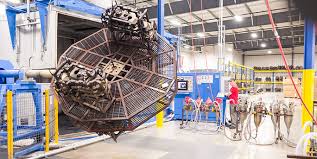Rotomolding also known as rotational molding is a method of manufacturing used to create hollow plastic parts. It’s an efficient and flexible process that creates high-quality, robust products that have a consistent wall thickness. This method is used extensively across various industries, including industrial, automotive, and consumer products.
How Rotomolding Works
Rotomolding involves the following essential steps: loading the mold, heating, rotating, cooling, and then demolding. The process starts by placing a pre-measured quantity of resin or plastic into a mold that is two-part. This mold then gets closed and then heated, usually using an oven. When the mold is heated, it begins to rotate across multiple axes, usually in a biaxial and a vertical direction. This rotation causes the plastic powder to melt and evenly cover the inside within the mold.
After the plastic has thoroughly covered the mold, and fused together, the mold needs to be typically cooled using water or air. The cooling process helps to solidify the plastic into the final shape. The mold is then removed and the newly formed component is removed. The result is a seamless hollow piece with a uniform wall thickness and excellent strength.
Advantages of Rotomolding
One of the major advantages of rotomolding’s ability to produce large complex shapes that have no joints or seams. This technique is particularly effective to create items such as tanks, bins and playground equipment. Additionally, rotomolding allows for the use of a wide range of materials, including various types of plastics such as polyethylene, polypropylene, and nylon.
Rotomolding is also renowned for its durability and resistance to impact. It allows the production of components with an even wall thickness, reducing the risk of weak spots or failures. It’s also a cost-effective choice for large to medium-sized production runs because of its relatively low tooling costs in comparison to other techniques like injection molding or blow molding.
Applications of Rotomolding
Rotomolding is utilized in a variety of applications due to its flexibility and the robustness of the final products. Some of the most popular applications are:
Industrial containers: Rotomolding can be used for manufacturing large storage tanks and containers used for agricultural processing, chemical processing, or water treatment.
Consumer Goods: Products like coolers, toys, and outdoor furniture are frequently produced using this method.
Auto Parts: Rotomolding can be used to make durable and light components, such as fuel tanks or protective housings.
Conclusion
Rotomolding is an efficient and versatile method for producing high-quality, hollow plastic components. Its capability to produce complex shapes that have uniform thickness, in conjunction with its low cost and long-lasting properties, make it a preferred choice across various industries. Whether for industrial, consumer or automotive purposes, understanding the fundamentals of rotomolding will help you in making informed choices about manufacturing requirements and capabilities.



